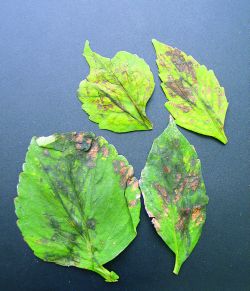Plant
Doctor Archive
Two-spotted
mite
  CAN
you help me with my dahlia problem? Six plants in the back garden
were the first to show signs, followed by those in the front garden,
and now the ones in the side garden have it too. I have had various
suggestions on what the problem is, from red spider mite to soil
deficiencies. What is your opinion? CAN
you help me with my dahlia problem? Six plants in the back garden
were the first to show signs, followed by those in the front garden,
and now the ones in the side garden have it too. I have had various
suggestions on what the problem is, from red spider mite to soil
deficiencies. What is your opinion?
 THE
leaf samples you sent had a mild infestation of two-spotted mite,
a tiny pest that feeds by sucking cell contents. They live mostly
on the undersides of leaves and thrive in hot, dry conditions, so
symptoms are worse in midsummer. THE
leaf samples you sent had a mild infestation of two-spotted mite,
a tiny pest that feeds by sucking cell contents. They live mostly
on the undersides of leaves and thrive in hot, dry conditions, so
symptoms are worse in midsummer.
The first signs of this
mite on your plants are pale patches appearing on the leaves. When
infestation is advanced, you may notice fine webbing on new shoots
and leaves, with older leaves drying out and dying. The adult mite
is just visible with the naked eye, pale orange in colour with two
dark patches on the lower half of its body, hence the name two-spotted
mite.
They attack a wide range
of plants in summer, including citrus, roses, runner beans and many
annuals and perennials. They dislike damp, moist conditions, so
this is one situation where watering in the evening and leaving
the foliage wet for as long as possible is actually a good thing
to do. Mite infestations vary depending on the weather, so in dry
summers they are worse than when there's regular rainfall.
You could do nothing
and next year they might not be a problem. If you want to try spraying,
it pays to choose carefully what you use, as many insecticides have
little effect on mites. Spraying oils, such as Conqueror and Super
Spraying Oil, are effective, but they can damage tender foliage
of some plants, particularly in hot, sunny conditions, so try on
one dahlia first and wait for a few days to see the result. Mavrik,
Mite Killer, Super Sulphur and Nature's Way Insect Spray can also
be effective. With all these, you need to make sure to get thorough
spray coverage on the undersides of the foliage so the spray actually
hits the mites. You'll probably have to apply three or four sprays
at 7-10 day intervals to really knock down the population.
Mite eggs survive over-winter
on the bark of many trees, shrubs and roses, so to help avoid another
infestation next season, you could give all deciduous shrubs in
your garden a good spray with Lime Sulphur or oil.
Weekend
Gardener, Issue 191, 2005, Page 29
Reproduced with permission from the former Weekend Gardener magazine. The views expressed here are not necessarily those of the RNZIH.
|
 |
 |
|